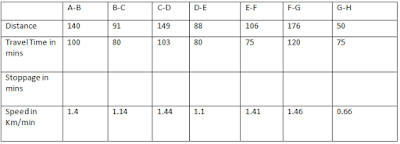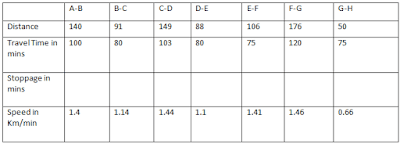Hello Friends, We are sharing some important Data Analysis and Interpretation & Caselets Questions with Answers solutions helpful for SBI and IBPS PO and Clerk exams 2017 2018. These data interpretation practice questions are very important for SBI PO exam and IBPS PO & other upcoming banking exams like for IBPS PO Pre and Mains, SBI PO Pre and Mains, SSC, CAT, XAT, NMAT, MAT & other exams 2017.
GRE Data Interpretation Questions and Caselets for bank exams provided by Bank4Study.com will help you a lot in your goal to crack the test. You will be taught to solve these questions better by solving many Data Interpretation and Caselets problems.
You need to practice as many DI Questions as possible for Competitive Exams to know data interpretation techniques. These questions will help you master the concepts of data interpretation better. Once you are sure that you have mastered the concepts involved in data interpretation, then you can easily crack the Quantitative Section of Exams.
You need to practice as many DI Questions as possible for Competitive Exams to know data interpretation techniques. These questions will help you master the concepts of data interpretation better. Once you are sure that you have mastered the concepts involved in data interpretation, then you can easily crack the Quantitative Section of Exams.
Data Interpretation Practice Questions
Questions 1 - 4 : Study the graph below and answer the questions that follow.- Railway Time Schedule of an Express Train X Running Between City A and City H
- a → Arrival of train d→ Departure of train
- A, B, C, D, E, F, G and H are cities through which the train runs. a-d→ Indicates stoppage/halting of the train at the city station.
Question 1: The average speed of the train maintained between two successive stations was maximum between
(a) E-F
(b) F-G
(c) G-H
(d) Both G -H and F-G
Question 2: Between how many pairs of consecutive stations does the speed run below the overall average speed of the entire trip?
(a) 4
(b) 1
(c) 3
(d) 2
Question 3: If the train stops at each city for 30% more time, then at what time will it reach the city H after departing from City A as per schedule?
(a) Data insufficient
(b) 17 : 03
(c) 16 : 41
(d) 16 : 58
Question 4: The train begins its onward journey from City A and it is extended to beyond City H to a City M due to some unavoidable reason. The train starts its return journey immediately after it reached City M. The train returns with a speed of 90 km/h without any stoppages in between and reaches City A at 2 : 25 am. Find the distance between City H and City M.
(a) 40 km
(b) 90 km
(c) 70 km
(d) None of these
What Others Are Reading
- Coding Decoding Questions Answers 25 Sets
- Puzzle 70 Sets for Exams - High Level
- How to Solve Input-Output Reasoning Questions Fast
- Blood Relations Questions - Shortcuts
- Seating And Circular Arrangement 95 Puzzles PDF 2017
- Series Completion Questions Tricks Shortcuts
- 10 Data Interpretation Sets - Free Download
Questions 5 - 9 : Study the graph below and answer the questions that follow.
Question 5: In which of the following years was the production of cars more than 50% of the total production?
(a) 2000
(b) 2001
(c) 1998
(d) 1996
Question 6. Find the total number of automobiles exported in the year 1999.
(a) 227600
(b) 207600
(c) 217600
(d) 220000
Question 7. Find the ratio of cars, scooters and motorbikes exported in 1996.
(a) 25 : 16 : 19
(b) 16 : 25 : 19
(c) 19 : 16 : 25
(d) 6 : 5 : 1
Question 8. If the ratio of export prices of a cars, scooter and motorbike was 2 : 1 : 1.5 in 1998, what was the proportion of their export earnings?
(a) 4 : 2 : 3
(b) 6 : 1 : 21
(c) 30: 16: 21
(d) Cannot be determined
Question 9. In which of the following years was the production of motorbikes exactly 40% of the total production of automobiles in that years?
(a) 1997
(b) 2000
(c) 1999
(d) 1996
Therefore, the correct option is (b)
Answer 2: (c)
Overall average speed = 800/633 = 1.264 km/min
Hence, between stations B-C, D-E and G-H the speed of the train was less than the average speed of the entire journey. Correct option is (c)
Answer 3: (c)
Now Increased stoppage time= 0.3 × 52 =15.6 min approximately 16 min
New arrival time = 16:25 + 16 = 16:41 min Correct option is (c).
Answer 4: (d)
Assuming the train starts its journey from M towards A at 16:25 Time taken to reach A from M= 24+2:25 – 16:25 = 10 hours.
Average speed = 90 Km/hr.
Total distance M-A = 90 × 10 = 900 Km. Total distance A-H = 800 Km.
Therefore, Distance between H and M is 900-800 = 100 Km. Correct option is (d)
Set 2 (Qus 5 - 9)
Answer 5: (a)
We have to check for those years where total value of production of scooter and bikes < value of car. By observation we can see that in the year 2000, the total production of cars was 860000 and the total production of scooters and bikes was 760000. Hence in 2000, the production of cars was more than 50% of the total production. Correct option is (a)
Answer 6: (c)
Total= 57600 + 120000 + 40000 = 217600
Correct option is (c)
Answer 7: (b)
Ratio: 134400 : 210000 : 159600 or 16: 25: 19.
Correct option is (b)
Answer 8: (c)
We have The ratio of cars: scooters: motorbikes = 225000 :240000 : 210000 = 225:240:210 = 45:48:42 or 15: 16: 14
The ratio of export prices of cars: scooters: motorbikes = 2:1:1.5
The ratio of export earnings of cars: scooters: motorbikes = 15 × 2: 16 × 1: 14 × 1.5 = 30: 16: 21
Option (c) is correct.
Answer 9: (a)
You don’t need to calculate for all the years. Calculations should be done for the years which are given in the options, since, ultimately one of them is the answer. The years which are marked as bold in the column are only to be calculated.
It can be clearly observed that in 1997 the motorbike production is 560000 which is 40% of the total production. Therefore, (a) is the correct option.
Hard Data Interpretation Solutions
Set 1 (Qus 1 - 4)
Answer 1: (b)
Answer 1: (b)
Answer 2: (c)
Overall average speed = 800/633 = 1.264 km/min
Hence, between stations B-C, D-E and G-H the speed of the train was less than the average speed of the entire journey. Correct option is (c)
Answer 3: (c)
Now Increased stoppage time= 0.3 × 52 =15.6 min approximately 16 min
New arrival time = 16:25 + 16 = 16:41 min Correct option is (c).
Answer 4: (d)
Assuming the train starts its journey from M towards A at 16:25 Time taken to reach A from M= 24+2:25 – 16:25 = 10 hours.
Average speed = 90 Km/hr.
Total distance M-A = 90 × 10 = 900 Km. Total distance A-H = 800 Km.
Therefore, Distance between H and M is 900-800 = 100 Km. Correct option is (d)
Set 2 (Qus 5 - 9)
Answer 5: (a)
We have to check for those years where total value of production of scooter and bikes < value of car. By observation we can see that in the year 2000, the total production of cars was 860000 and the total production of scooters and bikes was 760000. Hence in 2000, the production of cars was more than 50% of the total production. Correct option is (a)
Answer 6: (c)
Total= 57600 + 120000 + 40000 = 217600
Correct option is (c)
Answer 7: (b)
Ratio: 134400 : 210000 : 159600 or 16: 25: 19.
Correct option is (b)
Answer 8: (c)
We have The ratio of cars: scooters: motorbikes = 225000 :240000 : 210000 = 225:240:210 = 45:48:42 or 15: 16: 14
The ratio of export prices of cars: scooters: motorbikes = 2:1:1.5
The ratio of export earnings of cars: scooters: motorbikes = 15 × 2: 16 × 1: 14 × 1.5 = 30: 16: 21
Option (c) is correct.
Answer 9: (a)
You don’t need to calculate for all the years. Calculations should be done for the years which are given in the options, since, ultimately one of them is the answer. The years which are marked as bold in the column are only to be calculated.
It can be clearly observed that in 1997 the motorbike production is 560000 which is 40% of the total production. Therefore, (a) is the correct option.








